John Rohosky AIA, Architect, provides expert support on cases that run the gamut—from typical, to extraordinary. Most involve the following issues:
-
Design and Construction Defects
-
Building Permit/code compliance
-
Slips and falls: handrails, guardrails, stairs and sidewalks
-
ADA (Americans with Disabilities Act)
-
Standards of care (Architecture, Construction)
-
Personal Injury
-
Property line disputes (leaning buildings, walls)
-
Defending/prosecuting Architects or Contractors
-
Homeowner versus Contractor disputes
-
Insurance claims (defense and plaintiff)
Select Cases
Illegal and Incorrectly Built Deck
A deck was built incorrectly and without a building permit. This case included site inspection, written report, corrective architectural drawings, and permitting assistance. Required deposition and courtroom testimony. Outcome: Court found in favor of client for all costs.
Slips and Falls
For the last several years John has provided expert services in slip and fall cases involving building codes (current and historical), that generally involves crafting a Declaration for Motion for Summary Judgment (MSJ).
Examples
Plaintiff fell through a plate-glass window while exercising at a fitness facility
Outcome: Settled in favor of plaintiff
Plaintiff fell down stair at airport that was not provided with adequate handrails during adjacent construction work.
Outcome: Settled in favor of attorney’s client (plaintiff)
Plaintiff fell through improperly designed, maintained and secured snow hatch at timeshare condo during the snow season. Improvements to the property were added without permits, and without complying with the safety requirements of the Building Code.
Outcome: Won judgment for attorney’s client (plaintiff)
Plaintiff tripped and fell on stair after building occupancy (use) changed. Required current and historical code research.
Outcome: Settled in favor of attorney’s client (plaintiff)
Project Assessment and Development Costs
For an intra-family dispute whether to develop a jointly-owned property, conducted extensive research and evaluation of development costs and planning code requirements for the proposed project. Testified in court.
Outcome: Successfully defended attorney’s client
Architect/Contractor defense/countersuit
Contractor was removed from a project without being paid for work performed. Conducted extensive cost analysis, and provided a detailed report and expert testimony (deposition). Required expert court testimony.
Outcome: Judgment in favor of attorney’s client
Property line dispute and water intrusion
Two neighbors disputed the property line, including a property line leak at the roofs and walls. Inspected and investigated to develop report and provide detailed repair drawings and specifications, cost estimates, and scope of work for corrective work and construction. The analysis and report were instrumental in persuading an uncooperative contractor to perform according to agreed-upon court settlement.
utcome: Settled in favor of attorney’s client (plaintiff)
Fall
An employee of a dental office fell from a ladder used to access a storage area.
Outcome: Settled in favor of attorney’s client
Trip, Slip and Fall
This case involved a trip, slip and fall on a sidewalk ramp at a shopping center. We researched ADA code issues for this personal injury case.
Outcome: Settled in favor of attorney’s client (plaintiff)
Standout Cases
Occasionally, a case requires extraordinary expertise due to the standout nature of the issue.
Peephole (privacy issue)
A maintenance person drilled a peephole from the hallway janitor’s closet into an adjoining bathroom in one of the residential units in an apartment building, so that when the door of the medicine cabinet was shut it was not noticeable to the victim, but the person in the bathroom was visible through the peephole from the waist to the shoulder.
During the inspection for the plaintiff, we used a special camera inserted into the peephole to assess the extent to which we could see a person using the mirrored medicine cabinet door, that is, standing in front of it. The person was visible from the waist to the shoulder.
Outcome: Settled in favor of attorney’s client (plaintiff)
Monumental Staircase
(Is it, or not, a monumental staircase, architecturally speaking?)
In the 1960s, monumental stairs did not require handrails. This case involved a fall down an exterior stair at a suburban bank built in the 60s and renovated to be ADA compliant. The bank claimed their stair was “monumental,” and therefore did not need to comply with building codes, specifically handrails.
We helped defeat a summary motion strategy of the defense, even though the opposing side quoted a 1963 Code section that did not require handrails on a “monumental” stair. Through extreme historical sleuthing and research, and with a detailed and annotated report, we proved: 1) the stair was in fact not monumental; and 2) safety upgrades were required, in that a graspable handrail should have been installed initially, or later as a safety retrofit.
Outcome: Settled in favor of attorney’s client (plaintiff)
